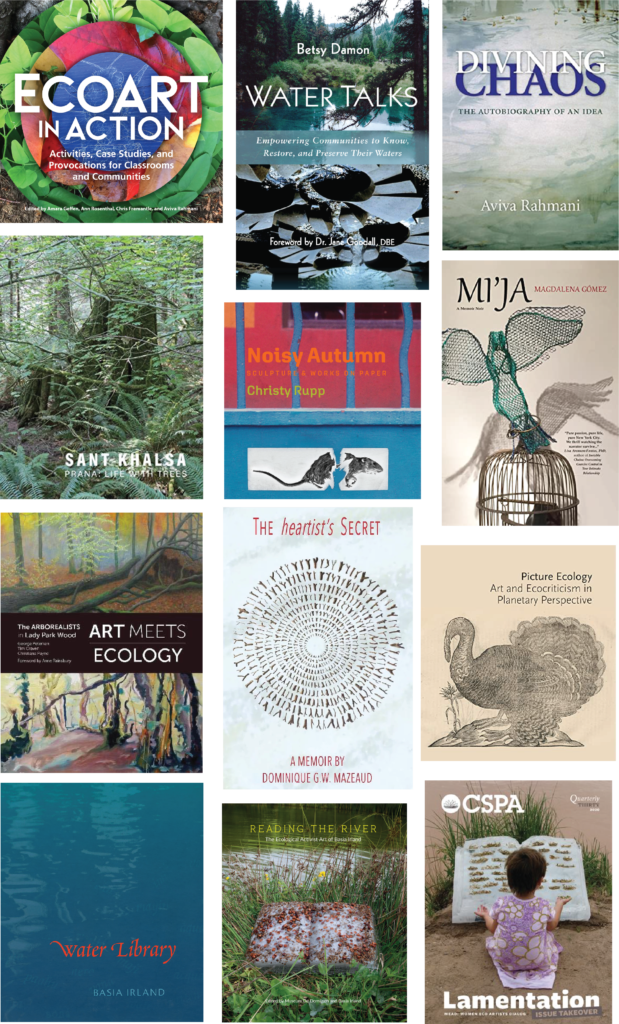
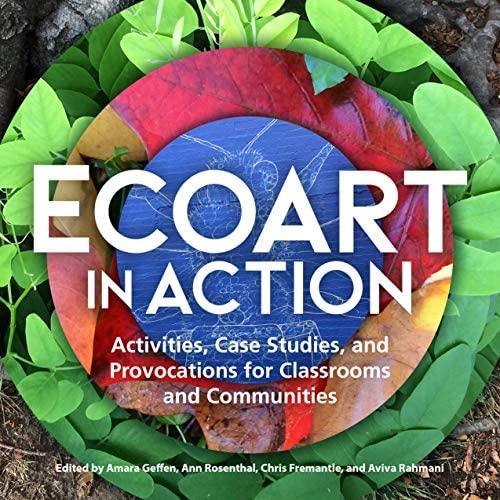 A. Geffen, C. Fremantle, A. Rahmani, and A. Rosenthal (Eds), 2002. Ecoart in action: Activities, case studies, and provocations for classrooms and communities. New Village Press
A. Geffen, C. Fremantle, A. Rahmani, and A. Rosenthal (Eds), 2002. Ecoart in action: Activities, case studies, and provocations for classrooms and communities. New Village Press
How do we educate those who feel an urgency to address our environmental and social challenges? What ethical concerns do art-makers face who are committed to a deep green agenda? How can we refocus education to emphasize integrative thinking and inspire hope? What role might art play in actualizing environmental resilience?
Compiled from 67 members of the Ecoart Network, a group of more than 200 internationally established practitioners, Ecoart in Action stands as a field guide that offers practical solutions to critical environmental challenges. Organized into three sections—Activities, Case Studies, and Provocations—each contribution provides models for ecoart practice that are adaptable for use within a variety of classrooms, communities, and contexts.
Educators developing project and place-based learning curricula, citizens, policymakers, scientists, land managers, and those who work with communities (human and other) will find inspiration for integrating art, science, and community-engaged practices into on-the-ground environmental projects. If you share a concern for the environmental crisis and believe art can provide new options, this book is for you!
Buy: https://nyupress.org/9781613321485/ecoart-in-action/
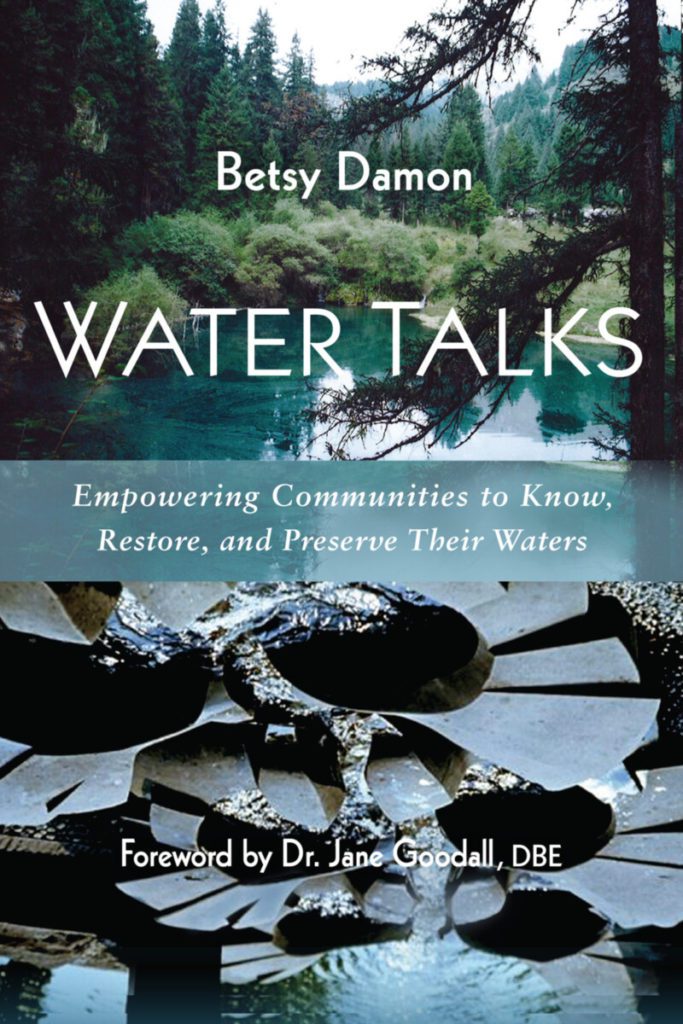
Damon, Betsy, 2022. Water Talks: Empowering communities to know, restore, and preserve their waters. Portal Books
The artist, activist, and teacher Betsy Damon has focused on virtually every aspect of water during the past four decades, from the essence of water drops to whole water systems and their connections to life on earth. Over the years, she has borne witness to the decline in water quality around the world as a result of human activities.
In this comprehensive, exciting, and accessible book, Damon writes about our interdependence with water in every aspect of life, discussing many of the technical, social, and ethical issues we face and our individual and communal responsibility for addressing the immanent crises we are facing. As she states, ‘Ignoring water’s essential role as the connective tissue of all life on Earth is widespread. Unfortunately, the response to each environmental problem tends to be piecemeal—addressing one threat rather than responding with complex solutions that will address the underlying problems.’
The author insists that genuine, lasting solutions require a fundamental understanding and empirical knowledge of water and its role for all life on Earth. She begins with an overview of water as a fundamental human right and how that right has been curtailed through wanton pollution and the commercialization of water supplies. Through personal stories and projects, scientific and technological studies, and encouraging solutions, she takes the reader through many ways in which we can better appreciate and approach existing problems so that ‘clean water, air, and soil would be available for all life without a price tag.’
As Jane Goodall points out in her foreword, this book ‘contains inspiring moments and successes of people and communities that have organized around saving a water place. It also provides rays of hope.’
Buy: https://steinerbooks.presswarehouse.com/browse/book/9781938685385/Water-Talks
 Rahmani, Aviva, 2022. Diving Chaos: The autobiography of an idea. New Village Press
Rahmani, Aviva, 2022. Diving Chaos: The autobiography of an idea. New Village Press
Aviva Rahmani has been a pioneering ecoartist since the 1970s. In Divining Chaos, she shows how artists and art have a vital role to play in addressing the looming ecocide that threatens to end civilization as we know it. Among Rahmani’s best known works is the acclaimed, The Blued Trees Symphony, in which she used a series of endangered forest sites, starting in New York state, as her canvas by painting trees with a blue marking that corresponded to the musical movements of an aerial symphony. Rahmani brought in communities with threatened lands across the world to participate in these installations. In an effort to save the trees from corporations intent on destroying them for natural
gas pipelines, she copyrighted the art’s relationship to the land. This project brought together community activists, lawyers, artists, and scientists. This novel use of the law stands as one of the most innovative acts of activism ever carried out by an artist. In Divining Chaos Rahmani shows how her development as an artist and an environmentalist are inseparable.
Buy: https://nyupress.org/9781613321669/divining-chaos/
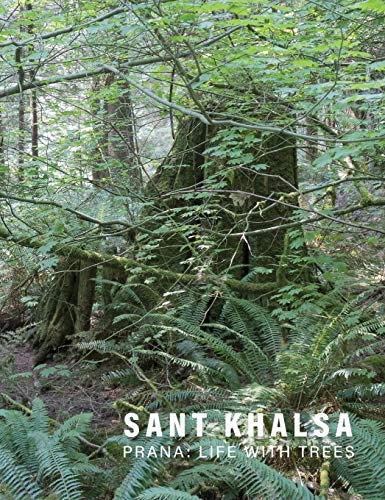 Khalsa, Sant, 2019. Prana: Life with trees. Griffith Moon
Khalsa, Sant, 2019. Prana: Life with trees. Griffith Moon
Sant Khalsa is an artist and activist whose projects develop from her impassioned inquiry into the nature of place and complex environmental and societal issues. Her artworks create a contemplative space where one can sense the subtle and profound connections between themselves and the natural world.
The subject of trees has been a focus in Sant Khalsa’s creative work for nearly five decades. Prana: Life with Trees is the first in depth survey of Khalsa’s intimate connection with trees – her explorations, observations, perceptions and interpretations. Her unique perspective is expressed through a style that encompasses the documentary, subjective and conceptual. Her work evokes a meditative calm to what we often experience as a chaotic and conflicted world.
Khalsa is concerned with both the micro and macro aspects of forests: what is seen and unseen; historical, scientific and spiritual; and personal and universal. She is mindful of our symbiotic relationship with trees and forests, grounded in the life-sustaining connection through the breath (exchange of carbon dioxide and oxygen). Her beautiful, distinctive and sometime disquieting works express the cycle of life (birth, life, death, and rebirth), the destruction and memory of the forest, as well as the promise of new growth.
The book includes her earliest landscapes (self-portraits and photographs of orange groves); images of trees from her three decades photographing in the Santa Ana Watershed and other locations in the American West; and mixed-media sculptures and installation works inspired by her research on air quality and life-changing experience planting more than a thousand trees in 1992 as part of the reforestation of Holcomb Valley in the San Bernardino Mountains. In her recent color photographs, we witness the fruits of her activism, a healthy, thriving and hopeful forest eco-system.
Sant Khalsa’s artworks are widely exhibited internationally, collected by prestigious museums including the Los Angeles County Museum of Art, Nevada Museum of Art and Center for Creative Photography in Tucson and published in numerous art books and periodicals. Khalsa is a recipient of prestigious fellowships, awards and grants from the National Endowment for the Arts, California Arts Council, California Council for the Humanities and others. She is a Professor of Art, Emerita at California State University, San Bernardino and resides in Joshua Tree.
Buy: https://griffithmoon.com/santkhalsa/
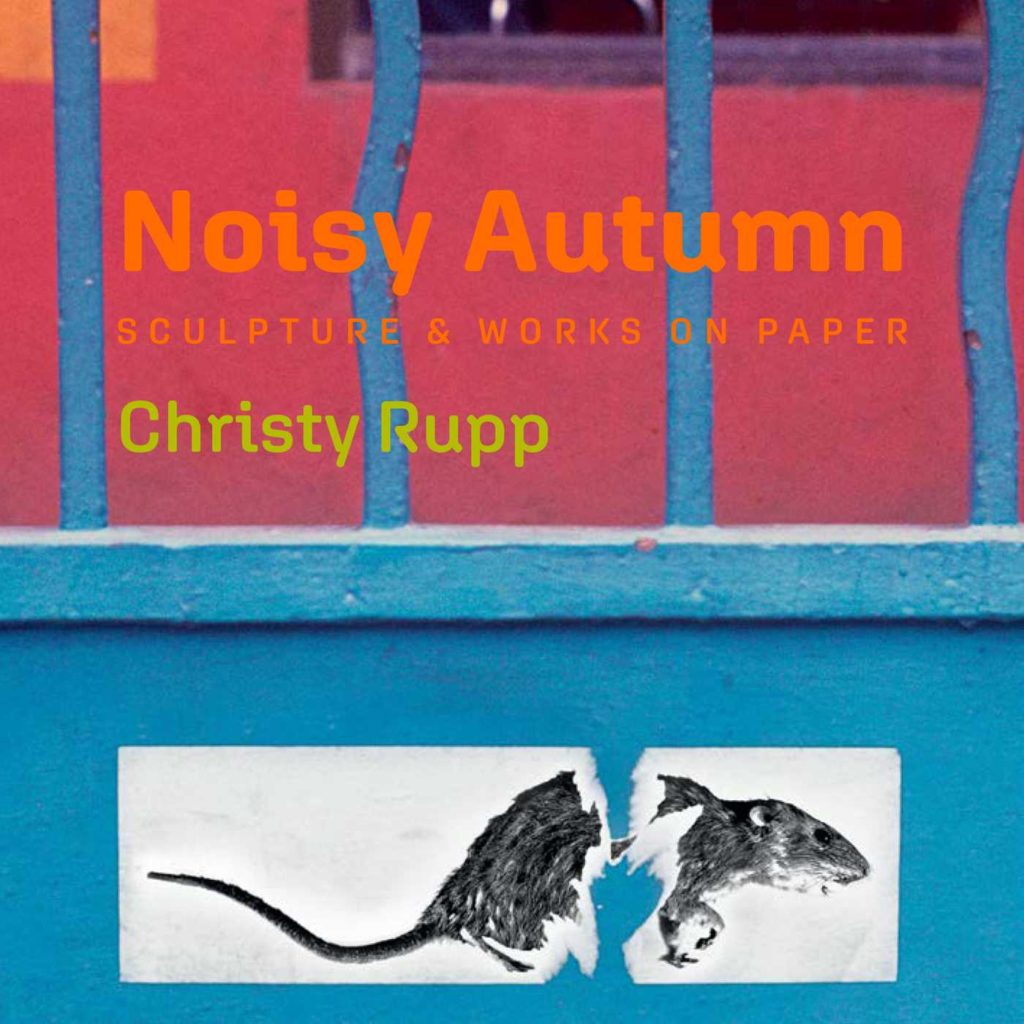
Rupp, Christy, 2022. Noisy Autumn. Mandala Editions
Inspired by Rachael Carson’s groundbreaking publication Silent Spring in 1962, this book brings together more than 4 decades of sculpture and works on paper by Christy Rupp, an artist working on the front lines of eco art since the 1970’s. Spotlighting the waste stream and its impact on habitat, the work takes aim at late capitalism in struggle with the planet. The accumulated residue of our heavy carbon footprint, found and recycled detritus is used to explore the complex entanglement we share with waste products, our habitat and remaining patches of wildness.
“This book displays the extraordinary variety of Rupp’s work over the years and the increasing urgency of her wide-ranging concentration on the cultural framing of nature, from Disney to scientific literature to the Hudson River School to current climate fiction. Long before Extinction Rebellion, Rupp began a lifework of advocacy on behalf of those who communicate differently, those we consider ‘Nature’ — as though we were not part of it, albeit an ignorant and dangerous part. ” – Lucy Lippard
“In her sculptures, birds, fish, mammals and micro-organisms
are fashioned out of the plastics, commercial packaging, credit cards and bits of
industrial debris that are contributing to their extinction. In her collages, several of
which are included here, she juxtaposes scenes of nature and industrial
development, wraps 19 th century landscape paintings in the wild embrace of
pipelines and oil tankers and combines naturalists’ drawings of biological specimens
with nature-based patterns that have been stylized, tamed and made decorative for
human consumption. These all provide vivid representations of the new geological
era scientists have dubbed the Anthropocene in which human activity is now the
primary driver of evolution and climate change.” Eleanor Heartney, February 2022
Buy: https://www.simonandschuster.com/books/Noisy-Autumn/Christy-Rupp/9781647224844

Gomez, Magdalena, 2022. Mi’ja. Heliotrope Books
Mi’ja is a new voice for old wounds, a time machine we are all invited to enter to reclaim the genius of our youth, an opportunity to revisit the loneliness and wonder of things we could see and understand only as children. At once heartbreaking and hilarious, Mi’ja chronicles the first nineteen years of the life of poet laureate, acclaimed playwright, and educator Magdalena Gómez-a life not meant for a child, nor is this book. It is fairytales and bestiaries in ceiling cracks; mythologies on the fire escape; realities of how the smallest acts of kindness can conquer despair. This book will reward you with revelations and celebrations of your own life; it may help you remember or perhaps even discover your truest, most honest self.”A fiercely honest, wickedly humorous, and immensely insightful look at the heart of a poet. Mi’ja takes the reader on a transformational journey. We witness how scars become jewels, how compassion and wit are the best revenge, and how a river of passionate words and stories can soothe the worst injustices. Gómez dances with her ancestors, despite the stale cookies and slaps of childhood. What a harvest! Mi’ja will make you take a deep healing breath.”
-Beverly Naidus, author of Arts for Change: Teaching Outside the Frame, One Size Does Not Fit All, and creator of the Pandemic Healing Deities series. Professor Emeritus, University of Washington, Tacoma
“Mi’ja belongs on your bookshelf between I Know Why the Caged Bird Sings and The House on Mango Street. Pure passion, pure life, pure New York City. We thrill watching the narrator survive, thrive and tell her tale. Brilliant!”
-Lisa Aronson-Fontes, PhD; psychologist, professor, Fulbright Scholar, global speaker, author of Invisible Chains: Overcoming Coercive Control in Your Intimate Relationship and Child Abuse and Culture: Working with Diverse Families.
“Magdalena Gómez’s searing honesty excavates what is dishonest within us. What she allows us to witness here is catharsis-hers, and ours-we will not carry the weight of abuse and oppression on our chests any longer. We will sing, and our liberation will terrify tyrants.”
-Diana Alvarez, PhD (a.k.a. Doctora Xingona) award-winning poet, songwriter, and opera composer, Quiero Volver: A Xicanx Ritual Opera
“Gómez unflinchingly shares how adult physical and verbal violence warps a child’s ability to love and causes psychological wounds with no statute of limitations. Her lyric grace renders so many painful moments into riveting vignettes and unforgettable imagery. Gómez’s skillful crafting of this memoir immediately earns its rightful place alongside contemporary memoirs such as Grace Talusan’s The Body Papers, Kiese Laymon’s Heavy, and Carmen Maria Machado’s In the Dream House.”-MarÃa Luisa Arroyo Cruzado, MFA, MAmultilingual Boricua poet Pushcart Prize nominee intersectional feminist educator of color inaugural Poet Laureate (2014-2016) of Springfield, MA; author of Gathering Words: recogiendo palabras and Destierro Means More than Exile
Buy: https://www.amazon.com/Mija-Memoir-Noir-Magdalena-G%C3%B3mez-ebook/dp/B09ZHFXGJ9
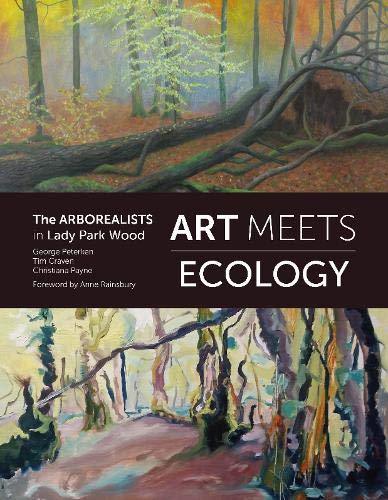 Peterken, George, 2020. Art Meets Ecology: The Arborealists in Lady Park Wood. Sansom & Co.
Peterken, George, 2020. Art Meets Ecology: The Arborealists in Lady Park Wood. Sansom & Co.
This book features the paintings and drawings created by The Arborealists – an informal group of professional artists with an interest in painting trees and woodland – in Lady Park Wood, an ancient, semi-natural wood on the slopes and cliffs of the Wye Gorge on the borders of England and Wales.
Uniquely, the wood, which has been left to grow naturally for up to 150 years, has been studied in detail since 1944 and the fortunes of hundreds of individual trees have been tracked for three-quarters of a century. The artworks are matched with a commentary by George Peterken, who has led the research since the 1980s. Both artists and ecologists observe trees and woods closely, but express their understanding of the wood in totally different forms. The two interests came together to deepen their understanding of each other and their different perspectives in an interest they share and promote a broader interest and understanding of native woodlands generally. Elm disease, the great drought of 1976, storms, snow and now ash disease have taken their toll on the ageing beech, oak, lime, ash, yew, hazel and many other species, many of which now lie prone in great heaps of dead wood and re-growth.
Buy: https://www.abebooks.com/Art-Meets-Ecology-Arborealists-Lady-Park/30925743611/bd
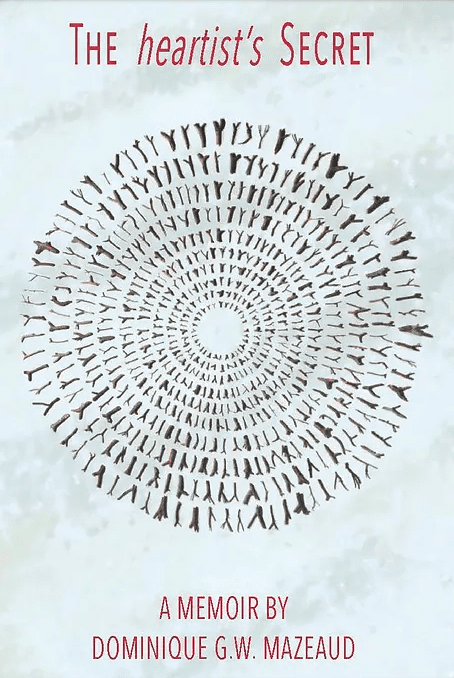 Mazeaud, Dominique, 2022. The heartist’s Secret: A Memoir. Earthheartist Publications
Mazeaud, Dominique, 2022. The heartist’s Secret: A Memoir. Earthheartist Publications
Dominique Mazeaud is an artist whose ritual performances and installations are considered prayers. Her passion is the Earht, and her identity belongs to Spirit. The word heartist reflects the gift of listening to Nature. The term results from Mazeaud’s quest for “the spiritual in art in our time,” which she has sought to answer since 1979. Heartist is a word unifying life and art and suggests a way of being in these transformation times. This book presents answers to her question, which she explores for herself and in a way that discovers the deep connectivity of all things on Earth. Dominique Mazeaud was born in France and has lived in the United States since 1967. In 1987 she moved to Santa Fe, New Mexico, where she resides today.
Buy: https://ecoartspace.org/Sys/Store/Products/274052
 Kusserow, Karl, 2021. Picture Ecology: Art and Ecocriticism in Planetary Perspective. Princeton University Art Museum
Kusserow, Karl, 2021. Picture Ecology: Art and Ecocriticism in Planetary Perspective. Princeton University Art Museum
Seeking a broad reexamination of visual culture through the lenses of ecocriticism, environmental justice, and animal studies, Picture Ecology offers a diverse range of art historical criticism formulated within an ecological context. This book brings together scholars whose contributions extend chronologically and geographically from eleventh-century Chinese painting to contemporary photography of California wildfires. The book’s fifteen interdisciplinary essays provide a dynamic, cross-cultural approach to an increasingly vital area of study, emphasizing the environmental dimensions inherent in the content and materials of aesthetic objects. Picture Ecology provides valuable new approaches for considering works of art in ways that are timely, intellectually stimulating, and universally significant.
With contributions by Alan C. Braddock, Maura Coughlin, Rachael Z. DeLue, T. J. Demos, Mónica DomÃnguez Torres, Finis Dunaway, Stephen F. Eisenman, Emily Gephart, Karl Kusserow, De-nin D. Lee, Gregory Levine, Anne McClintock, James Nisbet, Andrew Patrizio, Sugata Ray, and Greg M. Thomas.
Buy: https://www.amazon.com/Picture-Ecology-Ecocriticism-Planetary-Perspective/dp/0691236011
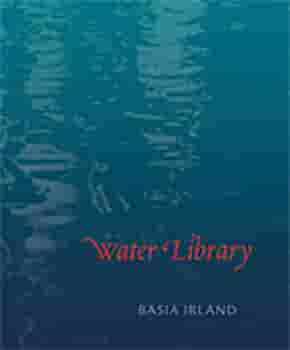 Irland, Basia, 2007. Water Library. University of New Mexico Press
Irland, Basia, 2007. Water Library. University of New Mexico Press
Water Library consists of nine interconnected sections focusing on projects that artist Basia Irland has created over the last thirty years in Africa, Canada, Europe, South America, Southeast Asia, and the United States. Through her work, Irland offers a creative understanding of water while examining how communities of people, plants, and animals rely on this vital element. With a humanistic and artistic approach anchored in science, Water Library is a tribute to ecology expressed through art. Irland’s art projects explore practical ways to conserve water through rain harvesting systems, how to foster dialogue and cooperation along the entire length of a river, and the dangerous impact of waterborne diseases on human health. By offering thought-provoking information, presented poetically, Water Library inspires in readers a broader appreciation of water’s importance in their everyday lives.
“[Basia Irland] harbors a visceral affinity with rivers and with our water-dominated planet as a whole, with its similarities to our own bodies of water, from tears to lowly piss to the breaking of waters at birth. Process, work in time, is all-important. Irland also acknowledges the significance of migration, of the ‘body in motion.’ Some of her sculptures are portable, companions on the journey.”–Lucy R. Lippard, art and cultural critic
Buy: https://www.amazon.com/Water-Library-Basia-Irland/dp/0826336752
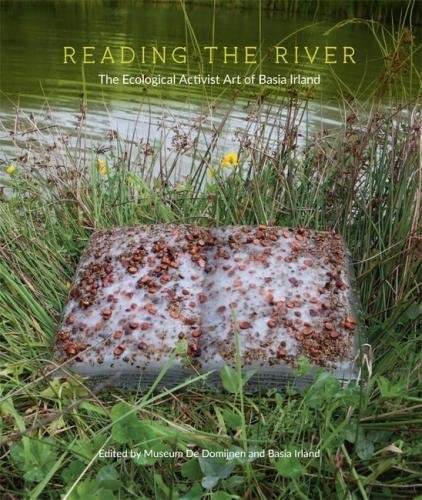 Irland, Basia, 2017. Reading the River: The Ecological Activist Art of Basia Irland. Museum De Domijnen Sittard-Geleen
Irland, Basia, 2017. Reading the River: The Ecological Activist Art of Basia Irland. Museum De Domijnen Sittard-Geleen
This publication was produced in conjunction with the retrospective Reading The River, Basia Irland’s first major solo exhibition in Europe, at Museum De Domijnen, Sittard-Geleen, the Netherlands, November 29, 2015 – February 21, 2016. In addition to documenting many of the works that were featured in the exhibition, this publication contains an extensive interview with the artist, a selection of her National Geographic blogs, and essays by notable art critics and academics. The book provides unique new insights into Irland’s development as an artist as well as her motivations, intentions, and working process. Through her sculpture, art installations, photographs, video documentaries, and blogs, Irland highlights the importance of water to our planet. Often engaging with local communities, she aims to connect people to their watersheds in order to motivate their appreciation and stewardship of this source of life.
Buy: https://www.amazon.com/Reading-River-Ecological-Activist-Irland/dp/9075883552
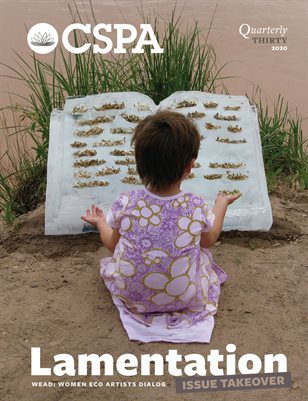 WEAD, 2020. Lamentation, CSPA Quarterly.
WEAD, 2020. Lamentation, CSPA Quarterly.
WEAD, Women Eco Artists Dialog, is a nonprofit focusing on women’s unique perspectives and contributions in the eco and social justice art fields. Our global constituency numbers 600+/- activist feminist art workers (inclusive reading of art, feminism, woman, gender). WEAD’s issue takeover Q30: Lamentation unearths GRIEF found in member’s art and words. Facing oppressive loss of critical ecosystems, where is hope?
Buy: https://www.magcloud.com/browse/issue/1892806
WEAD MAGAZINE ISSUE No. 13, THE ART OF EMPATHY
Published November 2022
